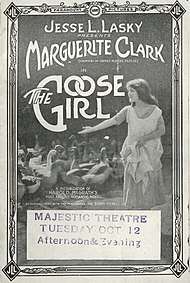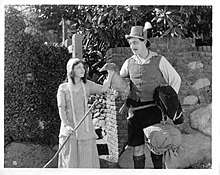The Goose Girl (1915 film)
The Goose Girl is a 1915 American silent drama film directed by Frederick A. Thomson and distributed by Paramount Pictures. The film is based on the 1909 novel of the same name by Harold McGrath and starred Marguerite Clark and Monroe Salisbury.
| The Goose Girl | |
|---|---|
 Ad for film | |
| Directed by | Frederick A. Thomson |
| Produced by | Jesse Lasky |
| Written by | William C. deMille (scenario) |
| Based on | The Goose Girl by Harold McGrath |
| Starring | Marguerite Clark Monroe Salisbury |
| Cinematography | Percy Hilburn (French) |
Production company | Jesse L. Lasky Feature Play Company |
| Distributed by | Paramount Pictures |
Release date |
|
Running time | 50 minutes |
| Country | United States |
| Language | Silent English intertitles |

Cast
- Marguerite Clark - Gretchen
- Monroe Salisbury - King Frederick
- Sydney Deane - Prince Regent of Jugendheit
- E. N. Dunbar - Grand Duke of Ehrenstein
- James Neill - Count Von Herbeck
- Lawrence Peyton - Von Wallenstein
- P. E. Peters - Carmichael
- H. B. Carpenter - Torpete The Gypsy
- Ernest Joy - Hans
- J. M. Casidy - Gottfried
- Miss Johnson - Princess Hildegarde
- Jane Darwell - Irma
Plot
Count Von Herbeck (Neill), an ambitious chancellor to the Grand Duke of Ehrenstein (Dunbar), secretly marries and has a daughter. At the urging of his dying wife, the count kidnaps the duke's infant daughter (Clark) and substitutes his own in the castle so that she may live in the style of a great lady.
The real princess, abandoned by the gypsies who abducted her for the count, is raised by peasants and given the name "Goose Girl." The young King Frederick (Salisbury) is betrothed to the impostor princess of Ehrenstein, whom he has never seen, but before the wedding takes place, he runs away and roams the countryside, where he encounters and falls in love with the Goose Girl.
After a series of adventures, during which Frederick decides to wed the false princess for the good of the country, the Goose Girl's true identity is revealed, and Frederick is delighted to learn that he is now betrothed to the girl of his heart.
Preservation status
This is now considered a lost film.[1][2]
See also
References
External links
| Wikimedia Commons has media related to The Goose Girl (1915 film). |
- The Goose Girl on IMDb
- The Goose Girl at AllMovie
- The Goose Girl still photo session at SilentHollywood.com